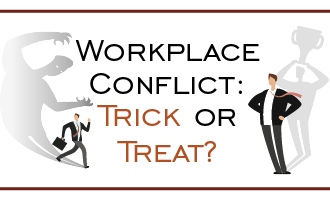Conflict is ubiquitous – it permeates all aspects of our lives. We all have needs, desires, and aspirations that are not always consistent with those of our colleagues, yet we live in a finite world with finite resources. Moreover, we are each unique, and have perceptions of the world that are filtered through our personal life experiences, including our family history, education, and belief systems. It is thus not surprising that conflicts occur on a daily basis at work – at and between all levels and areas of an organization, both internally and externally.
Despite its pervasive nature, however, conflict itself is neither “good” nor “bad” – it depends on how it is managed. If managed well, it can be a creative force for organizational change and growth. If managed poorly, it can be very harmful and costly. Most organizational leaders know that improperly managed conflict can potentially explode into catastrophic legal disputes that consume organizational resources and strain public relations.
Nonetheless, the ongoing cost of poorly managed internal organizational conflict is often not readily apparent: It can manifest in many ways, including a hostile work environment, the lack of employee buy-in to organizational goals, lost productivity, employee absenteeism and turnover, increased workers’ compensation claims, and increased theft and vandalism. Organizational leaders are often surprised by studies showing that the average employee spends over two hours per week, and 10% of employees spend six hours per week, dealing with unproductive work-related conflict. It is a decisive factor in 50% of employee turnover, and it costs 70%- 150% of annual salary to replace a departing employee, and even more for highly trained staff. These “hidden” conflict costs can be staggering.
The key to managing conflict in your organization begins with an open acknowledgment by leadership that a problem exists, hopefully before there is a “fire” to put out. Proactive conflict management is ALWAYS more efficient than reacting after a full-blown dispute has arisen or an organization’s culture has become toxic.
The “gold standard” approach to the remediation of destructive organizational conflict parallels that found in medicine – diagnosis followed by prescription. A “conflict audit” should be performed by a specially trained conflict management systems designer working with organizational personnel to pinpoint the genesis of any ongoing problems. The conflict audit can include, among other methods, specially designed surveys, individual interviews, and facilitated group discussions.
Once problems are identified, and leadership buy-in is confirmed, the systems designer will help organizational personnel develop metrics to define and measure a success outcome. The systems designer will concurrently help the organization develop appropriate processes, or simply enhance, modify, or supplement existing processes, to heal or improve the organization’s culture, and restore stability and productivity in the workforce. Good systems designers work with organizational personnel, and serve as a bench-marking researcher, information resource, idea generator, project coordinator, cheerleader, and facilitative communicator: They help an organization design and implement a conflict management system by and for itself.
The hallmark of any good conflict management system design is the deployment of interventions at the earliest possible time, at the lowest possible levels, and for the least possible cost. It is critically important that personnel experiencing an issue have the freedom to choose among multiple system entry options without fear of reprisal. System entry points can include, for example, an effective open door policy, human resources designee, peer coordinator, and/or ombudsmen.
Successful conflict management systems focus on prevention. The cornerstones of prevention include a comprehensive on-boarding program that explains how the system works, together with conflict management and de-escalation training properly tailored and implemented for all levels of the organization. By improving or developing the ability of all members of an organization to listen, hear, process, and communicate effectively in a high conflict environment will improve a toxic organizational culture, as well as de-escalate conflict so that it can lead to transformative individual and organizational growth.
The question for most organizations isn’t whether they should examine the need for an integrated conflict management system, but whether they can afford not to do so.
About David M. Doto/Of Counsel
David M. Doto is the Alternative Dispute Resolution/Training Practice Group Leader at Hutchison & Steffen. Dave focuses on the areas of mediation, group facilitation, organizational conflict management training, and conflict management systems design. Further, he is an adjunct professor of law at Pepperdine University and UNLV, where he teaches mediation, negotiation, mediation advocacy, and conflict management systems design.
